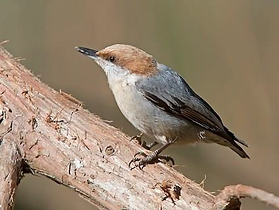Northern Bobwhite
Bobwhite are small quail with rounded bodies, small heads, rounded wings, and short tails. They are intricately patterned in brown, rufous, buff, and black. Males have a bold black-and-white head pattern, females have a buffy throat and eyebrow. Northern Bobwhites live in agricultural fields, grasslands, open pine or pine-hardwood forests, and grass-brush rangelands. They inhabit the early stages of regrowth after a fire, farming, logging or other disturbance and are most numerous in patchwork areas of fields, forests, and croplands.

Male bobwhite

Female bobwhite
There is much more information about bobwhites in this publication from the SCDNR.
Bobwhites are not the only birds that benefit from early successional and grassland habitat. A number of common and not-so-common species thrive in these surroundings and the SCBI whistle count surveys are measuring the response for all of these species in our focal areas.
Field sparrow
These are small, slender sparrows with relatively short, conical bills, rounded heads, and somewhat long tails. They seek open habitat with low perches, such as abandoned agricultural fields and pastures, fencerows, road and forest edges, and openings in wooded areas. They'll breed in fields that were recently burned or cultivated as long as there are trees or other perches available.

Bachman's sparrow
Similar in appearance to field sparrows, Bachman's sparrows are medium-sized with brown-streaked gray upperparts and buff underparts except for a white belly. Most often they are found in open pine or oak woods, palmetto scrub, bushy pastures and favor relatively open grassy areas. Historically they were most common in the understory of mature pine forest, where frequent fires limited the amount of brush; as mature pine forest has become scarce, more Bachman's sparrows are found clearcuts, powerline rights-of-way, old pastures, and other open areas.

Indigo bunting
Indigo buntings are small (roughly sparrow-sized), stocky birds with short tails and short, thick, conical bills. In flight, the birds appear plump with short, rounded tails. A mature male Indigo bunting is blue all over with slightly richer blue on his head and a shiny, silver-gray bill. Females are warm brown above with faint streaking on the breast, a whitish throat, and sometimes a touch of blue on the wings, tail, or rump. They breed in brushy and weedy areas and are common on the edges of woods and fields, along roads, stream, rivers and powerline cuts and in logged forest plots and abandoned fields where shrubby growth is returning.

Male indigo bunting

Female indigo bunting
Red cockaded woodpecker
Currently considered endangered, the red cockaded woodpecker was once fairly common in the Southeastern US. Causes for decline include suppression of natural fires, over-cutting of pine forest in southeast. It requires precise conditions within mature pine forest, a habitat that is now scarce. Ideal habitat is mature pine woods (trees 80-100 or more years old), with very open understory maintained by frequent fires (the pines are fire-resistant). Most common in longleaf pine, but inhabits other pines as well. The red cockade for which the bird is named, a small patch of feathers behind the eye of the male, is usually hard to see in the field.

Loggerhead shrike
In open terrain, this predatory songbird watches from a wire or other high perch, then pounces on its prey: often a large insect, sometimes a small bird or a rodent. The Loggerhead is gradually disappearing from many areas, for reasons that are poorly understood. It prefers semi-open country with lookout posts; wires, trees, scrub. Breeds in any kind of semi-open terrain, from large clearings in wooded regions to open grassland or desert with a few scattered trees or large shrubs.

Eastern meadowlark
Eastern meadowlarks are pale brown marked with black, with bright-yellow underparts and a bold black V across the chest. Though most of the tail is brown with blackish barring, the outer feathers are white and conspicuous during flight. They are chunky, medium-sized songbirds with short tails and long, spear-shaped bills. In flight, their rounded wings, short tails, and long bills help set them apart from other grassland songbirds. These small birds are most common in native grasslands and prairies, but they also occur in pastures, hayfields, agricultural fields, airports, and other grassy areas.

Prairie warbler
Found in various shrubby habitats, including regenerating forests, and open fields, the male prairie warbler wears olive-green upperparts, with rufous streaks on its back and has a bright yellow throat, breast, and belly. The female sports dull, unmarked olive upperparts with dark streaks on her sides.

Male prairie warbler

Female prairie warbler
Brown headed nuthatch
The nuthatch prefers pine forests, especially in open, mature forests with periodic fires. It climbs headfirst down tree trunks and has a crown that is dull brown. Its snderparts are whitish and its back, nape, wings, and rump are blue gray.

Eastern towhee
Towhees are a large sparrow. Look for their thick, triangular, bill. Also notice the chunky body and long, rounded tail. White corners in their tails are often seen in flight. They are characteristic birds of forest edges, overgrown fields and woodlands, and scrubby backyards or thickets.

Male eastern towhee

Female eastern towhee
Photos and descriptions courtesy of All About Birds at The Cornell Lab for Ornithology (www.allaboutbirds.org) and Audubon (www.audubon.org/field-guide/bird/)
